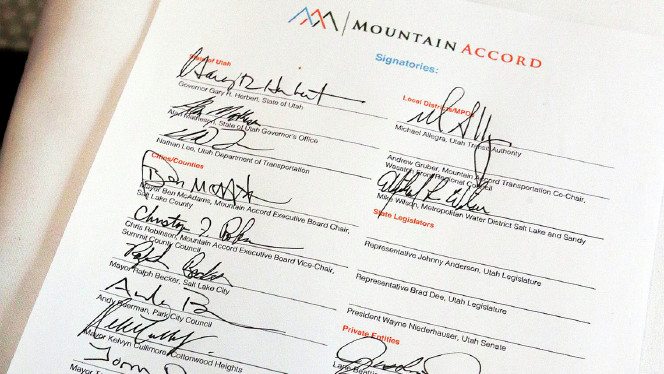Estimated read time: 4-5 minutes
This archived news story is available only for your personal, non-commercial use. Information in the story may be outdated or superseded by additional information. Reading or replaying the story in its archived form does not constitute a republication of the story.
COTTONWOOD HEIGHTS — The planning to address conservation, preservation and economic development of the central Wasatch Mountains' most critical recreation areas has begun in earnest.
Gov. Gary Herbert joined elected officials and local stakeholders Monday in officially signing the Mountain Accord — a 16-page document that represents the consensus positions of policymakers and community leaders working to develop a long-term plan to manage transportation and conservation interests in the central Wasatch Mountains while also balancing the protection of water and land resources with projected population growth and economic expansion.
"This has been a significant effort," Herbert said. "It's a proverbial win-win approach to how we protect and preserve our central Wasatch and still allow for the ski industry and (economic) development to occur that would be appropriate."

Ravell Call/Deseret News
While critics have expressed concerns that development could damage the natural environment of the canyons, the governor said the accord includes language that would preclude any harmful expansion.
"The intent of the accord is to make sure that we have transportation capability, but yet do nothing that would harm the environment or ecological systems or watershed," he explained. "The challenge will be to find a way to make it happen that follows (these principles). There are different approaches that can be taken, and there is no reason to believe that there cannot be a successful outcome."
The nonbinding document has no enforcement authority, so items in it are subject to change based on public feedback and other pertinent information.
Phase 2: Information gathering
The accord will now enter Phase 2, which includes significant research into each recommendation, continued public feedback, and completing an Environmental Impact Statement as part of the required National Environmental Policy Act process, explained project manager Laynee Jones.
The decision-making part of the process could begin this fall and would likely take about two years before any further determinations were made, she noted.
The accord represents the commitment of more than 20 organizations to proceed with proposals designed to ensure that future generations can enjoy all the activities Utahns enjoy today, while preserving the area's watershed and natural environment, Jones added.
The accord is intended to influence future local and regional planning, and initiate efforts to enact meaningful protections and preservation for the central Wasatch including:
- A federal land designation to create a National Conservation and Recreation Area that would specifically prohibit expansion of ski areas onto public lands beyond the resort area boundaries
- A recommendation to consider alternatives that disincentivize single-occupancy vehicle use in the Cottonwood Canyons
- A proposal to create an environmental monitoring "scorecard" to give decision-makers a way to track the area's environmental health and evaluate impacts in future planning discussions
- A proposal to clean up and organize the trails system in the canyons to control erosion and protect the watershed.
The transportation issue
Among the numerous proposed ideas written into the report are the expansion of transit options that could include trains to mountain resorts; a tunnel connecting Big and Little Cottonwood canyons; and the development of street-level transit along major thoroughfares leading up the canyons.
Salt Lake resident and biology researcher Pat Shea said while he generally supports the accord and its overall of goal of conservation and preservation, he would like to see every effort made to ensure that the watershed is protected and transportation solutions implemented that do not include rail or burrowing through the mountains.
We need to have mass transit. We need to have people who are going to use private cars pay (a toll) for them, and probably most importantly, we need to know the inventory of flora in the Wasatch so we can sustain the watershed.
–Pat Shea, Salt Lake City resident
"We can't afford to have a train or a tunnel," Shea said. "We need to have mass transit. We need to have people who are going to use private cars pay (a toll) for them, and probably most importantly, we need to know the inventory of flora in the Wasatch so we can sustain the watershed."
Jones said as the process moves ahead, the accord will target methods to develop effective mass transit. However, what mode that will be is still to be determined.
"We want to focus on moving people in a more environmentally sensitive way than using your automobile," she said. "We don't know if that means you won't be able to take your private car into the canyons or not. Those are the kinds of questions we are going to have to answer in the next phase."
Contributing: Geoff Liesik







